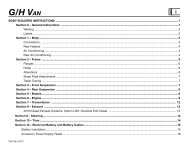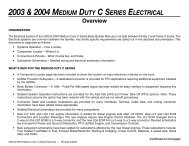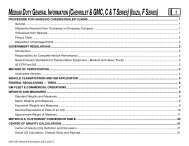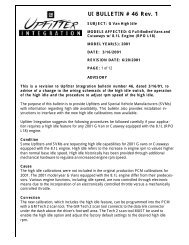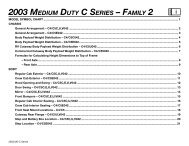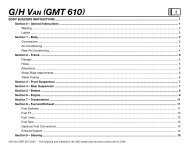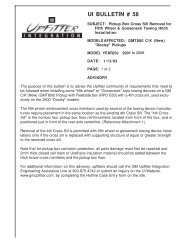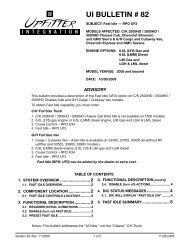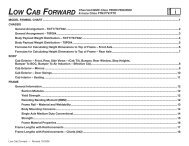s/t small utility – suv (chevy blazer & gmc jimmy) - GM UPFITTER
s/t small utility – suv (chevy blazer & gmc jimmy) - GM UPFITTER
s/t small utility – suv (chevy blazer & gmc jimmy) - GM UPFITTER
You also want an ePaper? Increase the reach of your titles
YUMPU automatically turns print PDFs into web optimized ePapers that Google loves.
S/T SMALL UTILITY <strong>–</strong> SUV (CHEVY BLAZER & <strong>GM</strong>C JIMMY)<br />
(Section 8 — continued from previous page)<br />
Tail pipe outlet location must be tested statically and with the vehicle in motion to ensure that exhaust gases do not penetrate side or rear<br />
windows or underbody seams and holes. Auxiliary power plants should also be tested under the same conditions. Tail pipe exit ahead of<br />
rear wheels is not recommended.<br />
Check for leaks in exhaust systems and repair as required.<br />
Any exhaust joint which has been disassembled must have the exhaust gasket replaced and the fasteners torqued to specifications.<br />
Re-check exhaust system for leaks.<br />
Exhaust temperatures can exceed 1600ºF under extreme operating conditions, with pipe surface temperatures slightly less than this.<br />
Extreme care must be used when placing body components in the proximity of the exhaust system so as not to exceed the rated<br />
temperature limits of the components. Due to variants in underbody configurations of the vehicles, we are not in a position to make<br />
recommendations on how to insulate or design components in the proximity of the exhaust system.<br />
Each manufacturer must make temperature checks of critical areas of his vehicle and adjust his design accordingly, or provide shielding to<br />
ensure safe operation of his body components.<br />
The same can be said for the engine compartment. Obviously there will be additional heat radiated from the engine. How much is retained<br />
in the area will depend on how well this area is ventilated in your individual designs. Here again, temperature checks of interior areas<br />
surrounding the engine should be made to determine if your insulation is adequate. This is the same engineering practice we have followed<br />
on our complete vehicles incorporating these exhaust systems.<br />
Exhaust system materials are selected and tested to withstand the operating environment of the vehicle. Do not modify the exhaust system<br />
in any way. The tail pipes are made of 409 aluminized stainless steel.<br />
Heatshields are mounted to the underbody and/or exhaust system components (catalytic converter, muffler and tail pipe). Shields for the<br />
propshaft hanger bearings are also provided in some vehicles.<br />
Section 9 — Steering<br />
Check power steering fluid level and system operations. (Refer to Owner’s Manual).<br />
The power steering hydraulic system should not be used to drive any other accessories.<br />
Steering wheel and horn pad must not be altered or replaced.<br />
The steering column mast jacket must not be altered.<br />
S/T Small Utility <strong>–</strong> SUV 2004<br />
PAGE<br />
10



